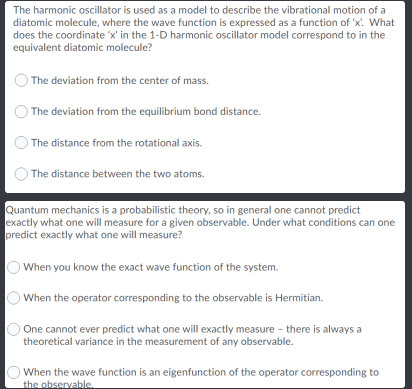The harmonic oscillator is used as a model to describe the vibrational motion of a diatomic molecule, where the wave function is expressed as a function of 'x' What does the coordinate 'x' in the 1-D harmonic oscillator model correspond to in the equivalent diatomic molecule? The deviation from the center of mass. The deviation from the equilibrium bond distance. ) The distance from the rotational axis. ) The distance between the two atoms. Quantum mechanics is a probabilistic theory, so in general one cannot predict exactly what one will measure for a given observable. Under what conditions can one predict exactly what one will measure? When you know the exact wave function of the system. When the operator corresponding to the observable is Hermitian. O One cannot ever predict what one will exactly measure - there is always a theoretical variance in the measurement of any observable. When the wave function is an eigenfunction of the operator corresponding to the observable.
The harmonic oscillator is used as a model to describe the vibrational motion of a diatomic molecule, where the wave function is expressed as a function of 'x' What does the coordinate 'x' in the 1-D harmonic oscillator model correspond to in the equivalent diatomic molecule? The deviation from the center of mass. The deviation from the equilibrium bond distance. ) The distance from the rotational axis. ) The distance between the two atoms. Quantum mechanics is a probabilistic theory, so in general one cannot predict exactly what one will measure for a given observable. Under what conditions can one predict exactly what one will measure? When you know the exact wave function of the system. When the operator corresponding to the observable is Hermitian. O One cannot ever predict what one will exactly measure - there is always a theoretical variance in the measurement of any observable. When the wave function is an eigenfunction of the operator corresponding to the observable.
Physical Chemistry
2nd Edition
ISBN:9781133958437
Author:Ball, David W. (david Warren), BAER, Tomas
Publisher:Ball, David W. (david Warren), BAER, Tomas
Chapter18: More Statistical Thermodynamics
Section: Chapter Questions
Problem 18.55E
Related questions
Question
1

Transcribed Image Text:The harmonic oscillator is used as a model to describe the vibrational motion of a
diatomic molecule, where the wave function is expressed as a function of 'x. What
does the coordinate 'x' in the 1-D harmonic oscillator model correspond to in the
equivalent diatomic molecule?
The deviation from the center of mass.
The deviation from the equilibrium bond distance.
The distance from the rotational axis.
The distance between the two atoms.
Quantum mechanics is a probabilistic theory, so in general one cannot predict
exactly what one will measure for a given observable. Under what conditions can one
predict exactly what one will measure?
When you know the exact wave function of the system.
When the operator corresponding to the observable is Hermitian.
One cannot ever predict what one will exactly measure - there is always a
theoretical variance in the measurement of any observable.
O When the wave function is an eigenfunction of the operator corresponding to
the observable
Expert Solution
This question has been solved!
Explore an expertly crafted, step-by-step solution for a thorough understanding of key concepts.
This is a popular solution!
Trending now
This is a popular solution!
Step by step
Solved in 2 steps

Knowledge Booster
Learn more about
Need a deep-dive on the concept behind this application? Look no further. Learn more about this topic, chemistry and related others by exploring similar questions and additional content below.Recommended textbooks for you

Physical Chemistry
Chemistry
ISBN:
9781133958437
Author:
Ball, David W. (david Warren), BAER, Tomas
Publisher:
Wadsworth Cengage Learning,

Principles of Modern Chemistry
Chemistry
ISBN:
9781305079113
Author:
David W. Oxtoby, H. Pat Gillis, Laurie J. Butler
Publisher:
Cengage Learning

Physical Chemistry
Chemistry
ISBN:
9781133958437
Author:
Ball, David W. (david Warren), BAER, Tomas
Publisher:
Wadsworth Cengage Learning,

Principles of Modern Chemistry
Chemistry
ISBN:
9781305079113
Author:
David W. Oxtoby, H. Pat Gillis, Laurie J. Butler
Publisher:
Cengage Learning